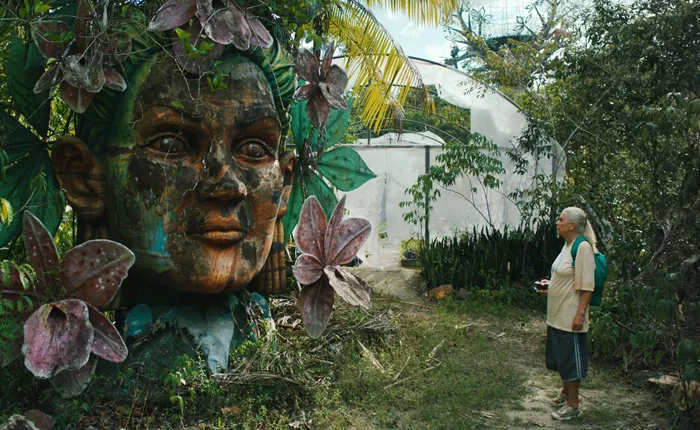In a cinematic landscape saturated with dystopian narratives, The Blue Trail (O Último Azul) stands out for its exhilarating, subversive take on the challenges of aging, personal autonomy, and societal oppression. Directed by Gabriel Mascaro, the film blends surreal elements with grounded social commentary, taking viewers on a journey of defiance and liberation led by a 77-year-old woman, Tereza, who refuses to accept the grim fate laid out by a government eager to erase the elderly from society.
Mascaro, who gained international acclaim with Neon Bull (2015) and Divine Love (2020), continues his exploration of bodies, autonomy, and societal control in The Blue Trail. However, this time, the director’s focus shifts toward the elderly and the bureaucratic forces that seek to strip them of their dignity. The plot is propelled by the physical and emotional metamorphosis of Tereza, played with remarkable nuance by Weinberg. Her journey becomes a rebellion against the oppressive system that enforces mandatory relocation for seniors to a remote “Colony,” a policy that robs them of both agency and respect.
The film’s imaginative world is populated by bizarre, hallucinogenic creatures—like the “blue drool snail” that produces a slime said to reveal one’s future—and outlandish devices, such as the “wrinkle wagons” where non-compliant elderly are hauled away. These quirky elements, paired with a heightened sense of reality, create a surreal backdrop to Tereza’s personal battle against a society that views aging as a burden. Yet, despite the fanciful touches, the film is grounded in the gritty, vivid reality of Tereza’s life in a small, factory-bound village on the banks of the Amazon.
The film begins with a society that glorifies productivity, where the elderly are shuffled aside to make way for the younger generations. Tereza, though skeptical of her place in such a future, is honored with a government award, a “national living heritage” medal, which she rejects with a gruff, “Since when is getting old an honor?” This cynical remark sets the tone for her rebellion against both societal norms and her own impending relegation to the “Colony.”
Mascaro’s critique of authoritarianism is sharp but subtle. The government’s policy of relocation, presented as a means of freeing younger generations from responsibility, is laced with chilling undertones. While no one ever returns from the Colony, the film remains ambiguous about whether this is an intentional form of generational cleansing. The occasional graffiti slogans—such as “Give me back my grandma” and “The elderly are not a commodity”—hint at growing unrest among the populace.
Tereza’s escape from this fate begins when she refuses to submit to the state’s constraints, embarking on a journey down the Amazon with the help of Cadu (Rodrigo Santoro), a shady riverboat pilot. Along the way, she encounters a series of characters and strange occurrences that shift her perspective on life. Cadu introduces Tereza to the mystical blue drool snail, whose secretive slime guides him on a feverish, fever-dream journey to reconnect with his lost love. In the process, Tereza learns vital lessons that fuel her transformation, including the knowledge that it’s possible to buy one’s freedom before being shipped off to the Colony.
As she travels deeper into the Amazon, Tereza’s sense of agency and joy gradually expands. She forms a close bond with Roberta (Miriam Socarrás), a free-spirited woman of a similar age who sells digital Bibles to remote communities. The two women share a warmth and camaraderie that sustains Tereza through her trials. Along the way, Tereza learns that even in the face of authoritarian oppression, there is always room for self-determination and rebellion, especially when it comes to the most basic human right: freedom.
The narrative’s picaresque nature allows for unexpected moments of humor, beauty, and tension. At its core, The Blue Trail is a meditation on resilience, self-discovery, and the power of defiance, even in the face of overwhelming odds. The film balances absurdity with gravity, never veering into the realm of kitsch, but instead staying grounded in the emotional and philosophical stakes of its central character.
Mascaro’s meticulous attention to visual detail also enriches the film’s thematic depth. The lush, iridescent landscapes of the Amazon serve as a vivid contrast to the sterile, controlling structures of the government. Guillermo Garza’s cinematography captures this dichotomy through intimate, tight frames that accentuate Tereza’s personal journey against the vastness of her surroundings.
Despite the starkly authoritarian world The Blue Trail depicts, it is a film filled with hope. As Tereza discovers the joys of movement, sexuality, and independence—whether through a spontaneous dance or a quiet moment of self-care—she finds strength in her own resilience, and in the relationships she forms along the way. The film’s closing image, unexpected and deeply uplifting, captures the essence of its central message: liberation is not confined by age, and the future belongs to all who refuse to surrender their freedom.
In a world rife with injustice, The Blue Trail reminds us that rebellion against the system can take many forms, and it’s never too late to reclaim one’s destiny. The movie is a breathtaking and moving celebration of life at any age—one that will stay with you long after the credits roll.
Related topic:
Bong Joon-ho’s ‘Mickey 17’ Brings Dark Sci-Fi Satire to Berlin
“Captain America: Brave New World” Falls Flat, Fails to Revive MCU’s Luster
‘Raju James Bond’ : A Quirky Local Heist Drama with Heart

